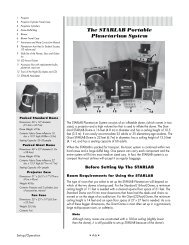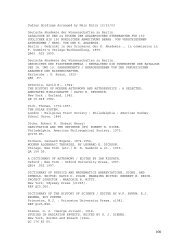K-6 Activities - Dudley Observatory
K-6 Activities - Dudley Observatory
K-6 Activities - Dudley Observatory
Create successful ePaper yourself
Turn your PDF publications into a flip-book with our unique Google optimized e-Paper software.
Objective<br />
Stellar Reference Points,<br />
Activity 6-6<br />
The student should be able to identify four major stellar reference points used in locating<br />
and describing positions of other stellar bodies.<br />
Background<br />
Stellar observers generally use well-known and easily identifiable astronomical<br />
features as reference points in locating other stellar features. Four common reference<br />
points are:<br />
1. Polaris<br />
2. Cassiopeia<br />
3. Pointer stars of the Big Dipper (Ursa Major)<br />
4. Orion’s belt<br />
Procedure<br />
• Have students identify the Big Dipper (Ursa Major). Locate the 2 stars which<br />
make up the end of the cup. These two stars, called the pointer stars, are most<br />
important. Using the arrow pointer, have each student point to these stars and<br />
draw a line through them and approximately five times the distance between<br />
them to locate Polaris, the North Star.<br />
• To reinforce the idea that all bodies seem to rotate around Polaris, slowly turn the<br />
cylinder and notice the phenomenon.<br />
• Have students find the star which joins the handle of the Big Dipper to the bowl.<br />
Follow an imaginary line from this star through Polaris (North Star) and continue<br />
in this direction until you find the “W” or “M” shaped constellation of Cassiopeia.<br />
Again, have each student follow the location procedure. If time permits, turn<br />
the projector off, turn the cylinder a 1/4 turn, turn projector back on, and relocate<br />
Cassiopeia.<br />
• To locate Orion (Orion the Hunter can be found in the southern sky throughout<br />
the winter), look for Betelgeuse (Beetle Juice)<br />
and Rigel (Ri-gel), the two brightest stars with<br />
Cassiopeia<br />
the three dimmer stars of the belt halfway<br />
between the two. From the three stars<br />
forming Orion’s belt, follow the line<br />
suggested by these three stars to<br />
Polaris<br />
the southeast. They lead to the<br />
very bright star, Sirius, the<br />
most apparently bright<br />
star of the night skies.<br />
Sirius is the bright<br />
star in the constellation,<br />
Canis Major<br />
or Big Dog. Canis<br />
Major is one of the<br />
Ursa Major<br />
two hunting dogs of<br />
Orion.<br />
(Illustration not to scale).<br />
Materials<br />
• STARLAB Portable Planetarium<br />
• Projector<br />
• Starfield Cylinder<br />
• arrow pointer<br />
• B–75 • K–6 <strong>Activities</strong>





